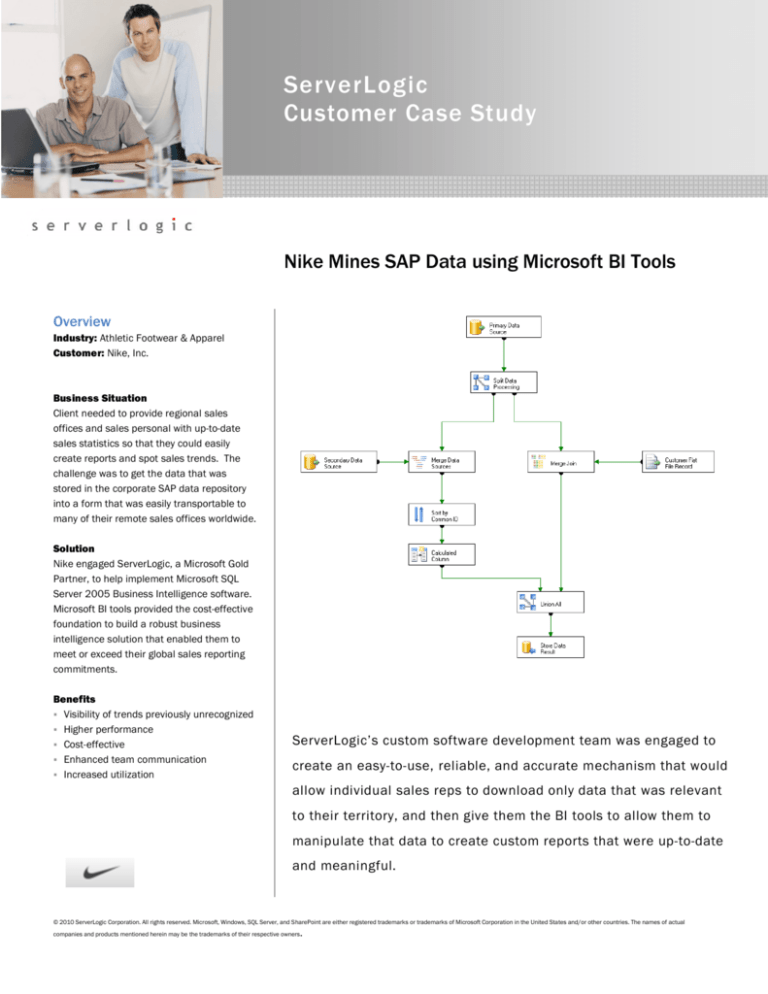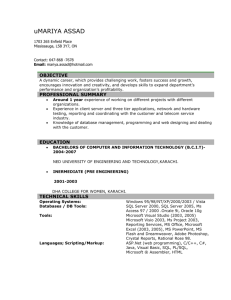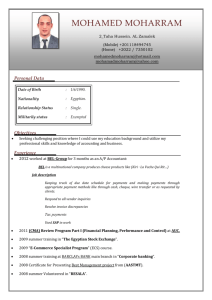
ServerLogic
Customer Case Study
Nike Mines SAP Data using Microsoft BI Tools
Overview
Industry: Athletic Footwear & Apparel
Customer: Nike, Inc.
Business Situation
Client needed to provide regional sales
offices and sales personal with up-to-date
sales statistics so that they could easily
create reports and spot sales trends. The
challenge was to get the data that was
stored in the corporate SAP data repository
into a form that was easily transportable to
many of their remote sales offices worldwide.
Solution
Nike engaged ServerLogic, a Microsoft Gold
Partner, to help implement Microsoft SQL
Server 2005 Business Intelligence software.
Microsoft BI tools provided the cost-effective
foundation to build a robust business
intelligence solution that enabled them to
meet or exceed their global sales reporting
commitments.
Benefits
Visibility of trends previously unrecognized
Higher performance
Cost-effective
Enhanced team communication
Increased utilization
ServerLogic’s custom software development team was engaged to
create an easy-to-use, reliable, and accurate mechanism that would
allow individual sales reps to download only data that was relevant
to their territory, and then give them the BI tools to allow them to
manipulate that data to create custom reports that were up-to-date
and meaningful.
© 2010 ServerLogic Corporation. All rights reserved. Microsoft, Windows, SQL Server, and SharePoint are either registered trademarks or trademarks of Microsoft Corporation in the United States and/or other countries. The names of actual
companies and products mentioned herein may be the trademarks of their respective owners
.
The Solution - Microsoft BI Tools
Solution Components
Given that the SAP data repository contained
hundreds of millions of rows of data stored in
complex multi-dimensional cubes, the first task
was to create a way to extract the correct data
and store it in a staging database where it
could be more easily manipulated. Working
with Microsoft and the client’s development
team, ServerLogic created a multi-threaded
.NET application, called MetaDriver, to move
data from the SAP Business Intelligence
warehouse into a Microsoft SQL Server staging
database. Some data could be moved in its
entirety – full replacement, while other data
had to be moved more intelligently by
appending new rows or updating deltas only.
Microsoft SQL Server 2005
MS SQL Server 2005 was used as a holding
area for data migrated from the SAP data
warehouse.
▪ ServerLogic engineers developed a .NET
application called MetaDriver to perform the
data migration from SAP into the SQL Server
repository database. SQL Server Integration
Services (SSIS) package templates were
written by other developers to perform
generic data migration tasks.
Once the fact and dimension data was
available in the SQL Server Repository, this
data could then be processed by Microsoft SQL
Analysis Services. Cubes were created which
represent the data’s hundreds of dimensions
and cube processing was initiated.
Microsoft Analysis Services 2005
SQL Server Analysis Services OLAP engine
makes use of SQL Server as its data source and
allowed the large amount of data in the staging
repository to be split into smaller CUB files
which are then distributed to each sales person
for remote processing.
▪ ServerLogic engineers researched methods
for initiating cube processing and for
generating CUB files.
When a cube had been processed, it was split
for transmission to the regional sales field
offices. Since sales data is broken down by
region, the cubes are also sliced across this
dimension. Once sliced, the sub-cubes are
transmitted using a parity checking utility to
speed up the transfer. Once the regional sales
office’s cubes are updated, the AMO APIs are
utilized to regenerate any linked dimensions.
Microsoft SQL Server Integration Services 2005
SQL Server Integration Services (SSIS) provided
the mechanism to move data from the SAP
Business Intelligence repository into the SQL
Server database.
▪ ServerLogic engineers developed a .NET
application called the MetaDriver, which
generated and executed SSIS packages
programmatically, based on database rules.
The sales data has traveled from the
company’s SAP data repository, to each
regional field office. Now it is ready for its final
move: to the sales person’s workstation. Using
MDX queries, Microsoft SQL Server Analysis
Services is now employed to split the OLAP
cube into CUB files for use by the sales staff.
These CUB files are slices of the cube along the
sales person dimension.
Microsoft Excel
Microsoft Excel provided an excellent OLAP
reporting interface, as virtually all of the client’s
sales staff were familiar with its use. Users can
add dimensions to the X and Y axes and view
the aggregated measures quickly. To provide
disconnected users access to the OLAP data, a
CUB file was generated by Analysis Services
and deployed to each user.
▪ ServerLogic provided research and proof of
concept. Other developers were responsible
for the final implementation.
Once the CUB file has been transmitted to the
salesperson’s laptop, they are ready to slice
and dice their data using Microsoft Excel. If a
sales person has a question about any
particular data element, they can click on the
“research” icon within Excel and get a full
description of the data element, its source and
meaning. This allows salespeople to create
reports, charts and predictions without needing
to be connected to the corporate intranet.
Microsoft Office Research Services
MS Office Research Services was employed to
provide access to the data dictionary. This
allows sales staff to right click any data element
from within the Excel report and get information
about its use and meaning.
▪ ServerLogic provided research and proof of
concept.
Microsoft .NET 2.0
ServerLogic’s primary role in this project was to
develop the MetaDriver application, used to
manage and monitor the flow of data from SAP
Business Intelligence into the Microsoft SQL
database and Analysis Server cubes.
▪ MetaDriver is a highly parallelized system for
running job batches. Any part of a job can be
marked “Serial” or “Parallel”, and
MetaDriver is also capable of executing
standard executables, .NET methods, SQL
scripts and stored procedures, as well as
SSAS tasks
MetaDriver is capable of determining which
parts of a job can be run together, and which
must run alone. Furthermore, the MetaDriver
is capable of doing this recursively: jobs can
have sub jobs, and thread control works to
the nth degree.
MetaDriver has a web interface that provides
the following features:
- Job Management: Jobs can be created,
modified and executed right from the web
interface.
- Parallelism Management
- Auditing and Logging: In addition to historical
logs, a real-time view into the MetaDriver is
provided by a Flash interface. This real-time
animated view allows the user to see the
interaction of parallel and serial tasks across
multiple jobs and threads.
- Parameter Management: MetaDriver settings
are stored in the database and can be
changed directly in the web interface.
Software and Services
−
−
−
−
−
−
−
−
Microsoft® SQL Server™ 2005
Microsoft Windows Server R2 x64
Microsoft IIS®
Microsoft SQL Server Integration Services 2005
Microsoft Analysis Services 2005
Microsoft .NET Framework 2.0
Microsoft C#.NET
Microsoft ASP.NET
For More Information
For more information about ServerLogic and our
custom software development services, call 866866838838-6932 or visit www.serverlogic.com
ServerLogic Corporation • 10260 SW Greenburg Rd, #540 • Portland, OR 97223 • 503-416-3110 • fax 503-416-3111 • www.serverlogic.com









